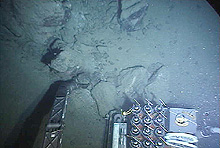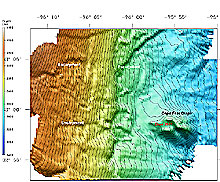
Seabeam bathymetric map in an area near the head of the Cape Fear submarine slide and the Cape Fear salt diapir. Dive 3911 explored the depression on top of the salt diapir. Researchers believe that gas hydrate and free gas in the sediments contribute to massive slope destabilization and the formation of features like the Cape Fear slide. Photo courtesy of C. Ruppel. Click image for larger view.
Exploration of the Cape Fear Diapir
July 29, 2003
Dr. Carolyn Ruppel, Co-Chief Scientist
Associate Professor
Georgia Institute of Technology
Catalina Martinez, Mission Coordinator
NOAA Office of Ocean Exploration
"I would liken this to planetary exploration…You might just get more of the same, but you will certainly know more at the end of the day than you started with." Chief Scientist, Carolyn Ruppel contemplating the next dive to the Cape Fear Diapir.
The known salt diapirs offshore of the Southeastern U.S. lie along a line just landward of the Carolina Trough, a major basin formed during rifting of North America from North Africa about 180 million years ago. These diapirs are usually buried beneath several hundred meters of sediment. But in the Cape Fear area, several diapirs lie close to the surface. The sediment and rock that formerly covered the diapirs moved eastward in a massive submarine slide about 20,000 years ago. The timing of the slide approximately coincides with the end of the last major global glaciation and the onset of over 100 meters of sea level rise caused by the melting of ice.
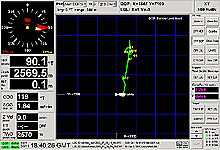
Dive track of the DVS Alvin as seen from inside the sub at the end of dive 3911 to the Cape Fear Diapir. Photo courtesy of Woods Hole Oceanographic Institution. Click image for larger view.
Several lines of evidence led scientists on board to postulate that the diapirs in the Cape Fear area might be associated with methane seeps. First, seismic data that penetrate hundreds of meters into the sediment show large amounts of gas beneath the region. Second, these diapirs lie close to the Blake Ridge Diapir, where the explorers conducted three dives during The Windows to the Deep expedition. Third, high temperatures near salt diapirs pinch the gas hydrate stability zone closer to the surface and drive the flow of fluids and gas from depth toward the surface. The geologic faults that always lie adjacent to salt diapirs tap into deep warm fluids that may reach the surface and sustain chemosynthetic communities.
Alvin dive 3911 was the first ever on the Cape Fear Diapir. The diapir has the shape of an inverted cone with steep sides that rise up to 275 meters above the surrounding seafloor. With seasoned Alvin pilot Phil Forte at the controls, graduate students Matt Hornbach and Rachel Horak descended on the diapir in search of geological and biological evidence for methane seeps.
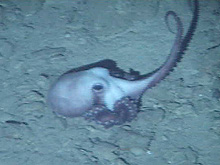
A large purple octopus as seen during dive 3911 at the Cape Fear Diapir at 2573 m. Photo courtesy of Woods Hole Oceanographic Institution. Click image for larger view.
Matt Hornbach, a Ph.D. student working with collaborating scientist Steve Holbrook at the University of Wyoming, dove as the lead (port observer) on this dive. Hornbach’s dissertation focuses on the distribution of gas beneath the Blake Ridge based on high-resolution seismic images acquired by the R/V Maurice Ewing in autumn 2000. The Seabeam and Chirp data collected during the Windows to the Deep expedition will directly contribute to his research on methane migration and the relationship of gas hydrates and free gas to submarine slides. The starboard observer for Alvin Dive 3911 was Rachel Horak, a Master’s student studying in the lab of co-Chief Scientist Cindy Van Dover at The College of William and Mary. Horak’s thesis focuses on DNA analysis of sulfide-oxidizing bacteria in free-living bacterial mats, vesicomyid clams, and mussels. Rachel will use samples collected during the Blake Ridge Diapir dives as the basis for some of her thesis research.
Alvin landed on the seafloor near Ocean Drilling Program Site 992 at the crest of the Cape Fear Diapir. The scientists immediately encountered a strange moonscape of hilly terrain, and over the crest of each rise they descended into another small basin bordered on all sides by more hills. Nearly everything was covered with a fine brown mud, which carpeted the seafloor like snow, smoothing out sharp features.
Near the landing site, the divers encountered the most biologically diverse location of the day. Several octopods, a deep-sea ray, scattered corals, and other creatures made them optimistic that a seep community might be nearby. An encounter with a large patch of shell fragments further buoyed their spirits. They searched for nearly an hour for the source of these shell fragments and whatever might be attracting the octopods and other organisms to this area.
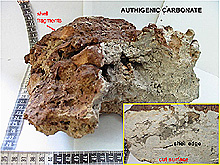
Authigenic carbonate rock collected on the Blake Ridge Diapir. Note how the carbonate matrix material cements shell fragments, creating a porous rock. A sediment-covered authigenic carbonate boulder was discovered on the Cape Fear Diapir and could mark the location of a former cold seep. Photo courtesy of C. Ruppel. Click image for larger view.
Microbial Diversity in Deep-Sea Sediments at the Blake Ridge Diapir
Heath J. Mills
PhD student Georgia Tech University
During a dive in the deep-sea submersible Alvin, the first observation made when the lights came on was the abundance and diversity of life present on the sea floor even at a depth of over 2000 meters. Large fields of mussels and clams were seen containing many different species of crabs and sea stars. Fish and shrimp in all shapes and sizes cruised effortlessly around the sub. All of this life was being supported not by the sun, but by converting geochemical energy into organic material to form a chemosynthetic community. Single-celled microorganisms present in the sediment and as symbionts living inside clams and mussels, living as hidden members of the ecosystem, accomplish this crucial first step in the food web. In these chemosynthetic communities, the microbes thus form the base of the ecosystem. Very little information is known about the diversity of these microbes found at the Blake Ridge diapir.
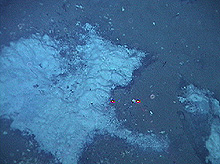
Although usually hidden, bacteria can be easily observed when found in large aggregations like this bacterial mat seen at the Blake Ridge Diapir. Mats indicate areas of potentially high microbial activity. Scientists typically focus on these mats when attempting to better understand the microbial processes in a new environment. The two red dots near the center of the image are laser pointers from the sub used to measure the size of a targeted object. These two points are always 10 cm apart. Click image for larger view.
Identification of the diversity and potential function of the microbes in the sediment is necessary to better understand the Blake Ridge diapir ecosystem. Unlike fish or sea star observations, the microbes cannot be characterized visually. Therefore, identification must rely on DNA-based molecular techniques. Different bacteria have different sequences of DNA. Isolating the bacteria’s DNA and reading the sequence can help us identify what type of bacteria was present in the sediment. Knowing the identity of the microbe provides insight into its potential function in the sediment. As increasing numbers of microbes are identified in this manner, more pieces of the ecosystem puzzle can be put into place.
Not all microbes isolated from the sediment will be significantly related to known bacterial lineages. Whereas the functionality of these novel bacteria inside the ecosystem will not be easily identified, they may prove to be a useful discovery. New lineages may produce chemicals or enzymes that are important in other fields such as medicine, bioremediation or food processing. Hunting for new types of bacteria, a technique now labeled as “bio-prospecting,” is a growing field that has displayed some promise for future discoveries. Whether scientists are exploring extreme environments like the Blake Ridge diapir using equipment like Alvin and attempting to explain how the organisms sustain life, or the scientists are hunting for microbial byproducts capable of enhancing our lives, understanding the microbial diversity is a necessary first step to unlock the wealth of information found just beyond our eyesight.



















